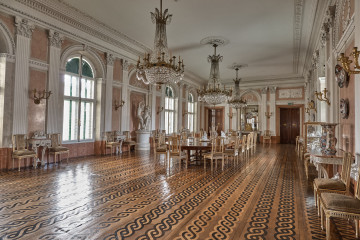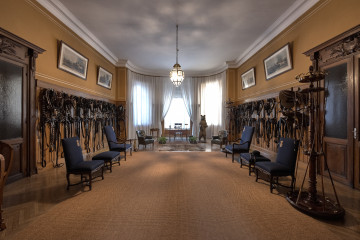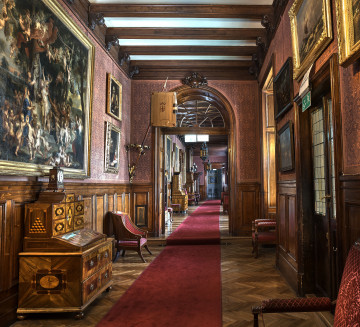
Great Dining Room
Castle Museum in Łańcut
Part of the collection: Interiors
Historical names: “Anti-Chambre” (ca. 1780); “Przed Pokoy” or “the Antechamber” (early. 19th c.); “the Dining Lounge” (19th c.); “the Dining Room”, “the Parade Lounge” (late 19th c.); “the Winter Dining Room” (1933)
Other names: The Entrance Salon
Time of construction: 1629–1642 (?); ca. 1780 – “Anti-Chambre”; after 1783-19th c. – change of decor and function; 1890s – change of decor
Architects: N.N. (1629-1890s); Amand Louis Bauqué, Albert Pio (1890-1895, change of decor)
Artists: Franciszek Smuglewicz (polychromy of south and north door, 1790s); Karol Chodziński and Jan Ciążyński (floor, 1830s); Viennese carpenters (1890s)
Description:
The Winter Dining Room, also known as the Entrance Salon, is located in the eastern enfilade of the castle’s first floor. Around 1780 it was the “Anti-Chambre” hall preceding the two apartments. One entrance from the hall led to Stanisław Lubomirski’s apartment (private apartments of the last Łańcut Lubomirskis in the northern wing). The second entrance led to the eastern suite, likely guests’. The passage in the western wall connected the “Anti-Chambre” with the corridor (Eastern Corridor). The interior was lit by two pairs of windows in the eastern wall. The room was heated by a fireplace and a stove placed in the southern wall.
In the early 19th century, the former “Anti-Chambre”, described as the “Antechamber” or “Przed-pokoy”, was illuminated by only two windows. The room had “linen upholstery, painted yellow with various old flowers”. Part of the interior was fenced off with a partition “in the same hall – timber covered with painted canvas”.
After the death of Izabela Lubomirska in 1816 and the division of property among her grandsons in 1822, Alfred I Potocki became the owner of Łańcut (he married Józefina Czartoryska in 1814).
The young Potocki family arranged their apartment in the rooms on the first floor of the eastern wing of the castle, called the Winter Apartment. It included the former “Przed Pokoy” turned into “The Dining Room”. Over time, it began to be called the Winter Dining Room.
The room's description says that in 1854 “In this living room, the ceiling and walls are painted, the oak floor is laid in sheets. Lute-shaped, brick stove. […] additionally, there is a partition in this Salon, made of polished boards, decorated with a painting under the varnish, on which the gallery is placed; wooden spiral stairs with handrails on both sides [...] leading to the upper floor.” There was also a door “with mahogany veneered, double [...] decorated with a painting, under the lacquer”. The passage to the corridor was closed by two doors –one-leaf “half-glazed” and a full-wing double one. The floor, designed by Karol Chodziński, and made of two types of oak by carpenter Jan Ciążyński, comes from the 1830s.
The furnishings of the Dining Room from the times of Alfred II Potocki and Maria née Sanguszko were recalled in 1885 by their daughter-in-law, Elżbieta née Radziwiłł, wife of Roman Potocki: “[…] the [eastern] corridor led to my in-laws' suite, the so-called winter apartments. The parade lounge was a very simple dining room: glued walls painted grey, [...] an old lyre-shaped stone stove, and in the corner, the same spiral stairs as today, moved by the old Mrs Alfred from the castle, as well as the beautiful mahogany door with paintings.”
After the death of Alfred II in 1889, during the reconstruction of the castle carried out for Elżbieta and Roman Potocki in 1889-1912 according to the designs of Amand Louis Bauqué and Albert Pio, the Dining Room was remodelled. The Potockis preserved both the spiral staircase in the north-eastern corner of the room and two pairs of mahogany polychrome doors in the passages of the eastern enfilade. Mythological or allegorical figures are placed in the central hexagonal fields apart from grotesque paintings in the door panels. There are images of Morpheus and Death in the northern ones and the southern – Flora and Ceres. The author of the paintings from the 1790s was likely Franciszek Smuglewicz. Similar images from the mid- 19th century depicting Mars and an unidentified woman were on the west door in the passage to the corridor. The additional glazed doors that existed here in the mid-19th century were dismantled.
The Winter Dining Room is panelled with gilded linden. The lower part of the walls is covered with panels. The walls in the upper part are covered with a green velvet fabric stretched over a loom panelling. The panelling is topped with a cubed cornice. Wooden door portals decorated with corbels are topped with cornice in the lintels and panels. Consistent with the interior design, the frames of the window recesses have panel shutters mounted on the hinges A stucco rosette is placed in the centre of the faceted ceiling. The corners of the southern wall are cut; in the south-east, there is a neoclassical stove from the late 19th century decorated with a medallion with the letter “P”. A 20th-century lamp complements the interior with a green silk lampshade (the castle was electrified after the construction of a private power plant in 1906).
After the Second World War, the Winter Dining Room has been renamed the Entrance Salon.
Basic bibliography:
• Kossakowska-Szanajca Zofia, Majewska-Maszkowska Bożenna, Zamek w Łańcucie, Warsaw 1964
• Majewska-Maszkowska Bożenna, Mecenat artystyczny Izabelli z Czartoryskich Lubomirskiej, Warsaw 1976
• Omilanowska Małgorzata, Jakub Sito, Łańcut i okolice [in:] Katalog Zabytków Sztuki w Polsce, Institute of Art of the Polish Academy of Sciences, Warsaw 1994
• Potocka Elżbieta, Łańcut – memoirs from 1885 to 1915 [Diary, typescript in the collection of the Castle Museum in Łańcut]
• Piotrowski Józef, Zamek w Łańcucie, Lviv 1933
Elaboration:
Teresa Bagińska-Żurawska https://orcid.org/0000-0002-9243-3967
Faustyna Bożętka
Object type
Interiors
Creation / finding place
Owner
Castle Museum in Łańcut
Identification number
Location / status

Castle Museum in Łańcut

Castle Museum in Łańcut

Castle Museum in Łańcut
DISCOVER this TOPIC
Museum of King Jan III's Palace at Wilanów
DISCOVER this PATH
Educational path